Shatter is a brittle, glass-like cannabis extract named for its breakability. It has a glassy appearance and tends to break, or shatter, like glass when snapped in two. Like other cannabis concentrates, shatter is a favorite among dabbing enthusiasts. Properly cured shatter comes from a careful and unrushed manufacturing process.
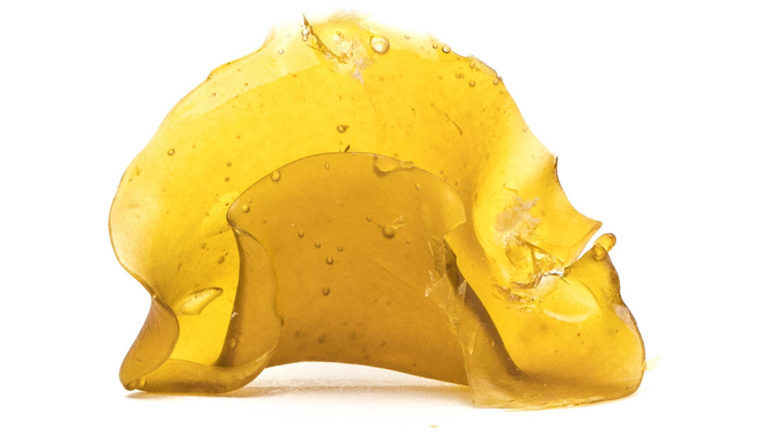 Photo by: Gina Coleman/Weedmaps
Photo by: Gina Coleman/WeedmapsImage lightbox

What is shatter?
Shatter is an extract, which is a type of cannabis concentrate produced using a combination of cannabis plant matter and solvents. The appearance of shatter weed is typically translucent, though its coloring can range from bright, honey-like amber to a darker yellow shade like corn oil.
Visually, all shatters may appear to have the same consistency, but the physical texture of individual marijuana shatter products can vary from extremely brittle to a taffy-like snap-and-pull quality, leading some to categorize the latter as pull 'n' snap. This inconsistency gives some insight into an individual product's concentration of cannabinoids.
Specifically, shatter that's higher in tetrahydrocannabinol (THC) will result in a product that has more sap or oil while a product with a higher level of tetrahydrocannabinolic acid (THCA) will be much more brittle and glass-like by comparison. At room temperature, THC concentrate is a sappy oil, giving shatter with a high THC content a more viscous consistency, whereas THCA is solid at room temperature, yielding a fragile concentrate that's easier to break apart.
What is CBD shatter?
While shatter is most well known for its high levels of THC, many concentrate makers also produce a variety shatter that is high in cannabidiol (CBD) and very low in THC. In general, CBD shatter is geared primarily toward consumers who want the potential medicinal and therapeutic benefits of the cannabis plant without the intoxicating effects of THC.
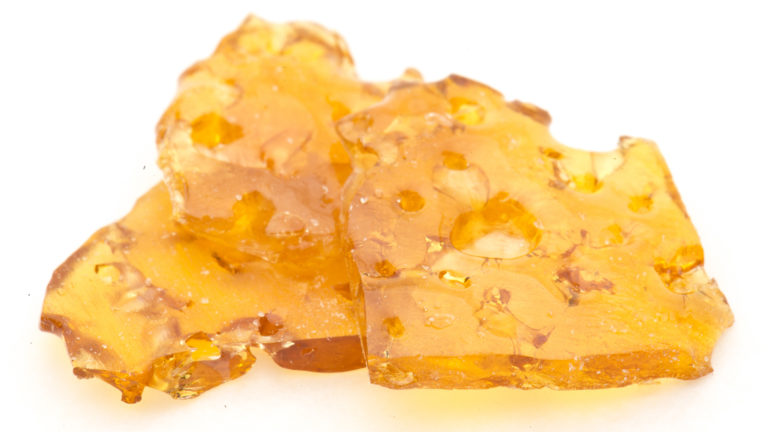 Photo by: Gina Coleman/Weedmaps
Photo by: Gina Coleman/WeedmapsImage lightbox

Because CBD shatter contains a concentrated, potent dose of CBD, it can be an excellent option for medical marijuana patients and other consumers interested in the potential health and wellness benefits of the cannabinoids and terpenes in cannabis concentrates. Just be sure to purchase shatter that has been manufactured specifically to contain high levels of CBD and low levels of THC, as this will maximize any therapeutic effects of CBD while minimizing the intoxication of THC.
What's the history of shatter?
Shatter is a relatively new addition to the history of cannabis consumption. Its roots can be traced to the age-old practice of hashish production. By the late 1990s the process of modern cannabis concentrate production was being refined, and what we'd now consider shatter was first produced.
In 1989 author D. Gold published a second edition of his 1973 book, Cannabis Alchemy: The Art of Modern Hashmaking, which included the first full explanation of how to make hash. A year later, in 1990, medical technologist Michael Starks also published a second edition of his 1977 book, Marijuana Chemistry: Genetics Processing and Potency, with a detailed account of the hash manufacturing process.
By the late 1990s, Canadian cannabis maker BudderKing first marketed budder and shatter, with its products hitting the shelves of dispensaries in 2003. The techniques for producing these products were published in Cannabis Culture magazine in 2005 and by the 2010s, shatter emerged as a staple method of cannabis consumption. Its popularity lead many dabbers and concentrate users to proclaim, “If it doesn't shatter, it doesn't matter.”
Frequently asked questions
Is shatter the same as dabs?
Technically, yes. All shatter can be dabbed, but not all dabs are shatter. Dabbing is a popular method of consuming cannabis concentrates that involves a small water pipe called a dab rig. The rig has a flat bowl and a “nail,” which is designed to tolerate high temperatures so it can vaporize the concentrate. In addition to shatter, other forms of cannabis concentrates can also be dabs.
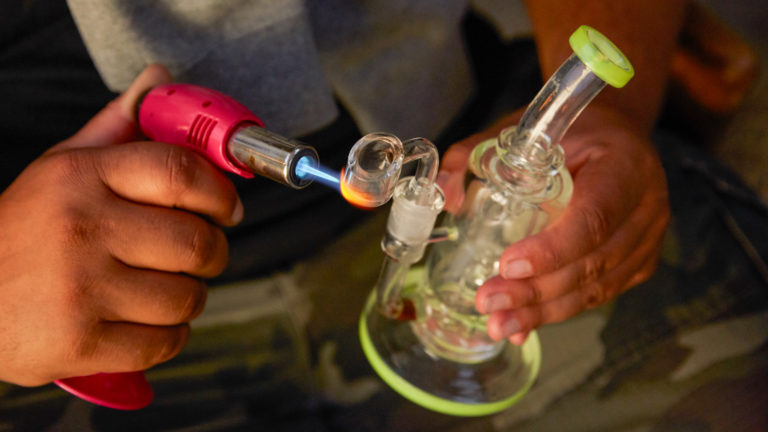 Photo by: Gina Coleman/Weedmaps
Photo by: Gina Coleman/WeedmapsImage lightbox

Dabbing concentrated marijuana products like shatter typically offers a more potent high, as well as terpene-rich flavors and aromas, especially compared with smoking marijuana. Unlike smoking though, dabbing marijuana shatter does require the right tools and a certain amount of know-how, which can make first-timers nervous. The temperature of the nail at the moment of consumption, for example, will affect flavor, and may alter any potentially healthful effects.
What are the side effects of shatter?
As shatter and other marijuana concentrates have significant THC levels, it's important to be mindful of the potential adverse effects that may come from consuming cannabis this way. Though THC may have some medical and therapeutic uses, overconsumption could cause unpleasant experiences, such as anxiety and paranoia. If you're new to these substances, start with the smallest viable dab and gradually increase your dose to avoid these unwanted side effects.
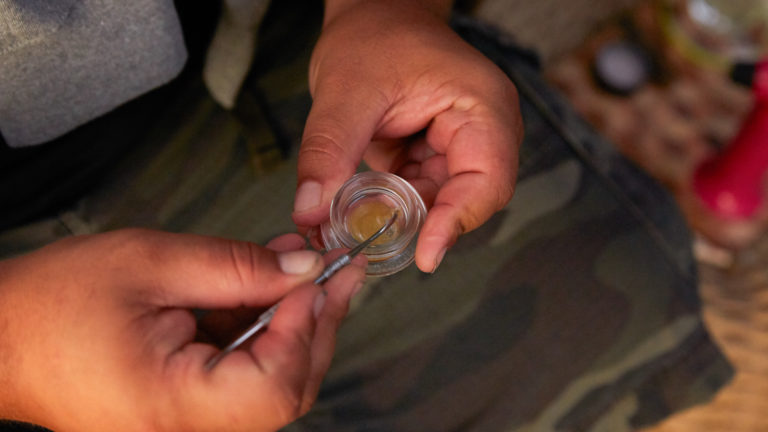 Photo by: Gina Coleman/Weedmaps
Photo by: Gina Coleman/WeedmapsImage lightbox

What happens if you eat shatter?
Shatter requires decarboxylation, or the activation of its compounds through heat, to produce the desired result. This form of concentrate is meant to be vaporized using a dab rig, e-rig, vape pen, or vaporizer, which decarboxylates the potent cannabinoids so they can interact with the body immediately. Consuming unheated shatter is unlikely to produce any desirable effect.
How should I store shatter?
When stored improperly shatter can begin to break down and lose its initial snappy consistency, flavor, and potency. To prevent this degradation, it should always be stored in an airtight, lightproof container. Ideally, it should be stored in a cool room. To ensure the concentrate stays consistent for as long as possible, protect it from high temperatures, moisture, oxygen, ultraviolet light, and direct sunlight.
Remember, heat is shatter's worst enemy. It causes the cannabinoids to activate. That should happen only upon consumption, not while it's resting in a container. Dispensaries, smoke shops, and many online stores offer concentrate storage accessories such as silicone containers, and most cannabis concentrates come in appropriate containers that may be reused.
Why does shatter turn into sugar, budder, or crumble?
Despite the wide range of textures, colors, and consistencies of cannabis extracts, they all have similar production processes. If certain steps aren't closely followed, if solutions are mishandled at any point of production, or if the shatter isn't stored correctly, it may ultimately yield something other than the translucent, glass-like product. Other factors may affect the production process. Agitation, high temperatures, residual solvents, or leftover moisture from the marijuana plant material all can cause the cannabis oil to end up as budder, rather than yielding the desired snap or brittleness of shatter.
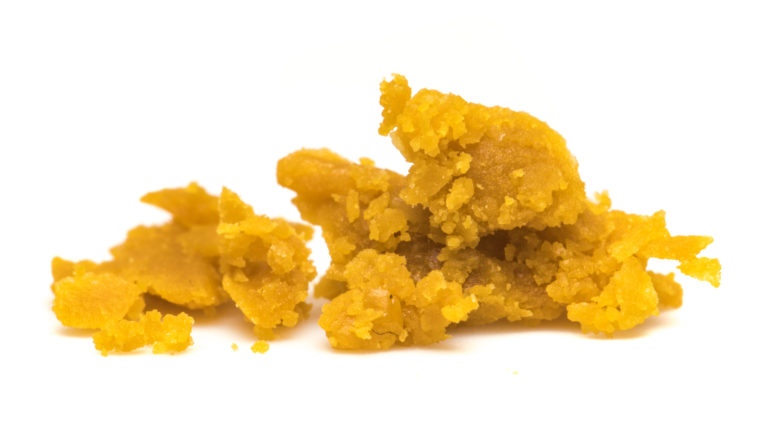 Photo by: Gina Coleman/Weedmaps
Photo by: Gina Coleman/WeedmapsImage lightbox

How is shatter made?
First, a quick warning: only professionals should manufacture shatter and other solvent-based cannabis concentrates because these processes can be extremely dangerous and illegal in many jurisdictions.
The overall process for producing this concentrate is the same as other cannabis extracts. The most significant difference is the post-extraction process. Shatter is typically made by passing a pressurized solvent through a chamber packed with plant material. The solvent separates the desirable cannabinoids and terpenes from the plant matter before it's removed through a purging process. Shatter starting material can be anything from cannabis flower buds to cannabis plant remnants such as trim or shake.
Shatter can be made with myriad solvents, but the most common is butane (which produces butane hash oil or BHO) though solvents such as liquefied petroleum gases (LPG) or ethanol can also be utilized. Carbon dioxide, or CO2, extraction is used for other cannabis concentrates, but CO2-extracted shatter would lack its characteristic texture, as this extraction method removes the moisture from the plant matter.

